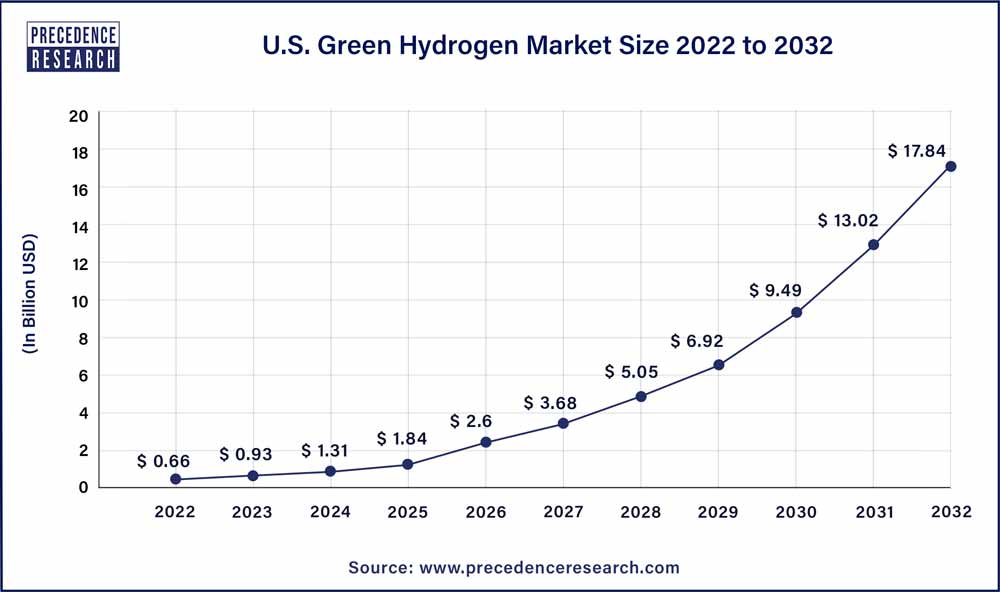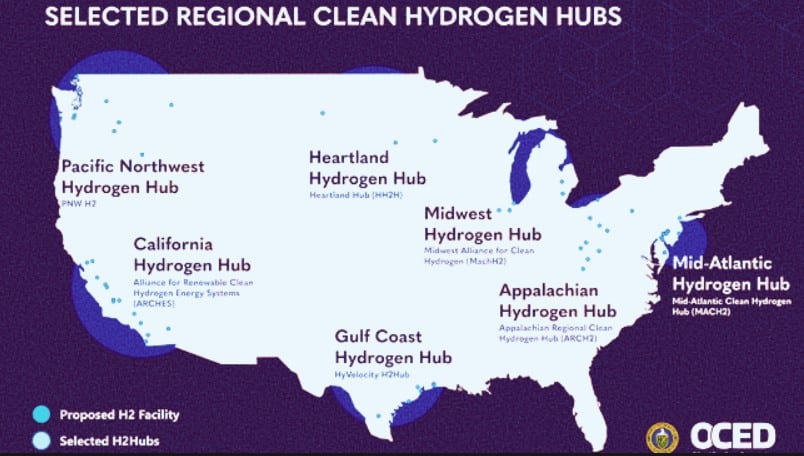President Biden’s Investing in America agenda has allocated $50 billion to launch 7 Regional Clean Hydrogen Hubs (H2Hubs), an initiative that the Department of Energy (DOE) will support with a $7 billion grant.
This comprehensive plan is part of a strategic move to accelerate the deployment of low-cost, clean hydrogen across the country. Designed to create jobs, increase energy security, and fight climate change, the investment marks a significant milestone in America’s transition to a clean energy future.
Fueling Emission Reductions, Driving Sustainability
Clean hydrogen, also known as green hydrogen, production in the United States will grow from almost nothing last year to >10 million metric tons in 2032 (almost $18B in size). This includes the 7 hydrogen hubs chosen to receive the grants.
 Funded by the Bipartisan Infrastructure Law, the H2Hubs will produce 3 million metric tons of hydrogen annually. It will also support the production, storage, delivery, and end-use of clean hydrogen, while reducing emissions from hard-to-decarbonize industrial sectors.
Funded by the Bipartisan Infrastructure Law, the H2Hubs will produce 3 million metric tons of hydrogen annually. It will also support the production, storage, delivery, and end-use of clean hydrogen, while reducing emissions from hard-to-decarbonize industrial sectors.
The funding will go to 7 selected regional hubs located in carbon-producing centres, including Appalachia, Gulf States, and the Midwest. Together, they will cut about 25 million metric tons of CO2 from end-uses each year.
The regional hubs will also create and retain tens of thousands of jobs, contribute to healthier communities and reinforce the nation’s commitment to environmental sustainability.
Clean hydrogen serves as a versatile energy carrier that can be produced from various clean energy sources such as renewables, nuclear, and fossil fuels with carbon capture.
- RELATED: An Introduction to Hydrogen Energy
By using these resources, the H2Hubs can significantly reduce harmful emissions from energy-intensive sectors. For instance, the chemical and industrial processes, as well as heavy-duty transportation will largely benefit from using clean hydrogen. All these while creating economic opportunities across the U.S.
The selected H2Hubs will share the cost in developing the network, alongside the Energy Department’s historic $7B investment. Their share is estimated to be over $40 billion, driving significant private sector investment in clean hydrogen. Read more about the seven selected projects in the following list below.
The 7 Chosen Hydrogen Hubs in America
-
Appalachian Hydrogen Hub:
The Appalachian Regional Clean Hydrogen Hub (ARCH2) in West Virginia, Ohio, Pennsylvania will utilize the region’s natural gas resources to produce low-cost clean hydrogen and store carbon emissions. With an allocated budget of up to $925 million, it aims to create over 21,000 jobs. It will benefit the Appalachian community through job opportunities and cost-effective hydrogen distribution.
-
California Hydrogen Hub:
The Alliance for Renewable Clean Hydrogen Energy Systems (ARCHES) in California will produce hydrogen exclusively from renewable energy and biomass. It is particularly aiming to decarbonize the key emitters in the state – transportation and port operations. The project plans to generate 220,000 jobs, with a budget of up to $1.2 billion.
-
Gulf Coast Hydrogen Hub:
The HyVelocity H2Hub will center in Houston, Texas and will focus on large-scale hydrogen production using natural gas with carbon capture and renewables-powered electrolysis. It anticipates creating around 45,000 direct jobs, with an allocated budget of up to $1.2 billion.
-
Heartland Hydrogen Hub:
This project in Minnesota, North Dakota, South Dakota, will leverage the region’s energy resources, aiming to reduce agricultural sector emissions and facilitate clean hydrogen use in electric generation and heating. It plans to create around 3,880 jobs, with a budget of up to $925 million.
-
Mid-Atlantic Hydrogen Hub:
The Mid-Atlantic Clean Hydrogen Hub (MACH2) in Pennsylvania, Delaware, and New Jersey will unlock hydrogen-driven decarbonization, utilizing innovative electrolyzer technologies. With an allocated budget of up to $750 million, it expects to to create 20,800 jobs.
-
Midwest Hydrogen Hub:
The Midwest Alliance for Clean Hydrogen (MachH2) will be in Illinois, Indiana, Michigan – a key U.S. industrial corridor. The hub will facilitate decarbonization across multiple sectors, including steel and glass production, power generation, and transportation. Leveraging diverse energy sources like renewables, natural gas, and nuclear energy, it aims to create 13,600 direct jobs, with a budget of up to $1 billion.
-
Pacific Northwest Hydrogen Hub:
The PNW H2 will cover Washington, Oregon, Montana, will produce clean hydrogen through electrolysis, driving down costs and promoting accessibility. It aims to generate over 10,000 jobs, with an allocated budget of up to $1 billion.
Promoting Economic Growth, Benefiting Communities
Each hydrogen hub is tailored to leverage the unique characteristics and energy resources of its respective region. The projects will harness the potential of clean hydrogen in diverse sectors, including agriculture, manufacturing, and transportation, driving economic growth.
More importantly, the Administration emphasizes the importance of community engagement and benefits in the development of the hydrogen hubs. Each H2Hub has to implement a comprehensive Community Benefits Plan (CBP) to ensure that the initiative benefits all communities.
To ensure the long-term success of the clean hydrogen economy, the DOE has issued a Request for Proposals for a demand-side initiative. This is crucial to provide market certainty for both producers and end-users in the H2Hubs.
Apart from hydrogen producing companies, who would be the other winners of the $7B federal hydrogen grants? Big oil and electric utilities will also benefit from the DOE investment.
Among the listed partners in the H2Hubs construction and operation are the major oil companies, including ExxonMobil and Chevron. Exxon, alone, has pledged $7 billion to produce hydrogen in the U.S.
Natural gas companies will also benefit from the hydrogen funding and will use the gas to power turbines. Popular names include Dominion Energy, Xcel Energy, and the AES Company.
And clearly, key players in the hydrogen market can take advantage of the historic investment.
Nikola and its hydrogen fueling stations will benefit from the grant, and so will other companies developing hydrogen fuel cell vehicles (FCEVs). FCEVs are gaining traction, with growing interest and demand for these vehicles, especially for long-haul trucking and parcel deliveries.
As such, First Hydrogen Corp. (TSXV: FHYD) (OTC: FHYDF) (FSE: FIT) will surely benefit from the projects once the hubs become functional. The company is poised to capitalize on the emerging zero-emission fleet vehicle market led by FCEV.
The clean hydrogen hub program, managed by the DOE’s Office of Clean Energy Demonstrations (OCED), represents a significant step towards achieving the Biden-Harris Administration’s ambitious climate and energy goals. It will lay the groundwork for a cleaner, equitable, and more sustainable energy future for the country.
Disclosure: Owners, members, directors, and employees of carboncredits.com have/may have stock or option positions in any of the companies mentioned: FHYD.
Additional disclosure: This communication serves the sole purpose of adding value to the research process and is for information only. Please do your own due diligence. Every investment in securities mentioned in publications of carboncredits.com involves risks that could lead to a total loss of the invested capital.

